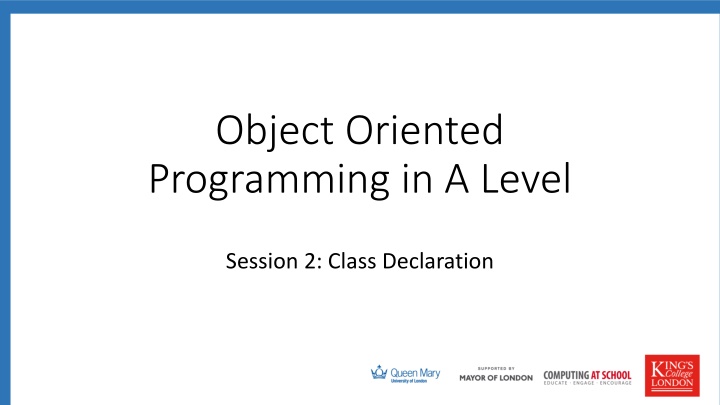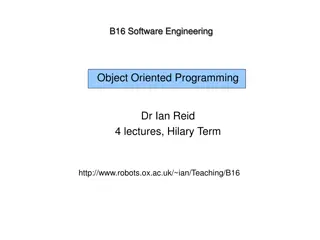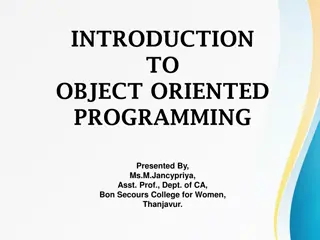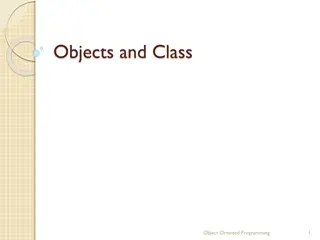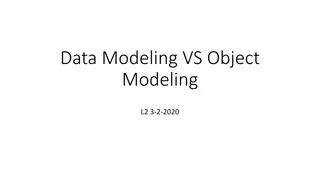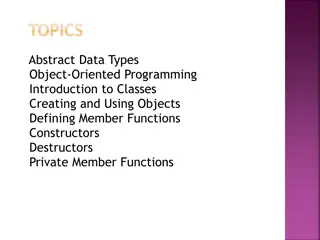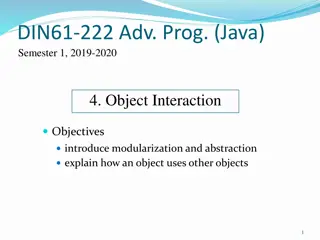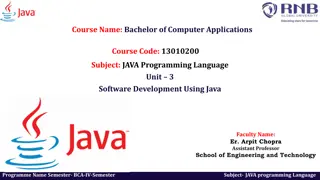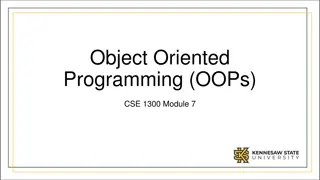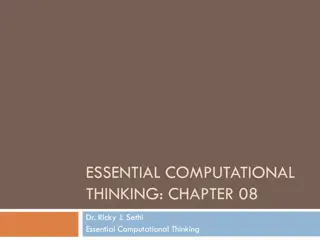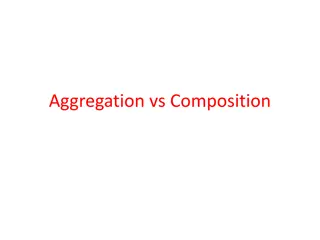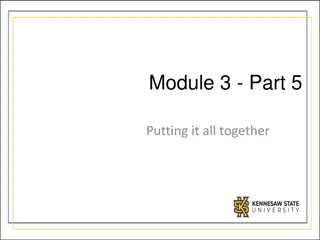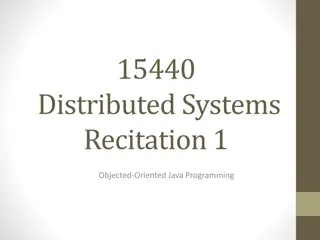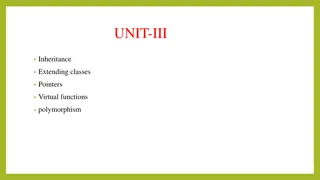Object-Oriented Programming Basics for A-Level Students
Explore the fundamentals of object-oriented programming through class declaration, use of objects and methods, decomposition, abstraction, and more. Dive into topics like declaring classes, inheritance, polymorphism, and class diagrams. Gain insights into Python programming, modules, constructors, fields, and organizing programs into files. Enhance your understanding of classes, objects, attributes, and constructors to build a strong foundation in OOP.
Download Presentation

Please find below an Image/Link to download the presentation.
The content on the website is provided AS IS for your information and personal use only. It may not be sold, licensed, or shared on other websites without obtaining consent from the author.If you encounter any issues during the download, it is possible that the publisher has removed the file from their server.
You are allowed to download the files provided on this website for personal or commercial use, subject to the condition that they are used lawfully. All files are the property of their respective owners.
The content on the website is provided AS IS for your information and personal use only. It may not be sold, licensed, or shared on other websites without obtaining consent from the author.
E N D
Presentation Transcript
Object Oriented Programming in A Level Session 2: Class Declaration
Course Outline Session Topics Use of objects and methods Decomposition and abstraction Aims of learning OOP Declaring classes Attributes, methods and the constructor Composition of classes Classes diagrams; visibility Inheritance, overriding and polymorphism More class diagrams Teaching issues Review and practical examples 1 2 3 4 5
Recap of Week 1 Explored ideas of abstraction and decomposition - Many mechanisms for decomposition e.g. functions, modules, classes - Decomposition needs practice more than just learning the mechanisms - Guidance: decompose using abstractions Emphasis on continuity of OOP File: example of an abstractions - Hides information (e.g. location on disk) File: example of using objects - Create an object e.g. open function - Act on object e.g. write method Where objects / classes come from? How do I declare my own classes?
Person versus Nearly Person Method / Example Description Two implementations of an abstraction - OOP, using a class - Non-OOP, functions in a module Person("John") p.setJob("brickie") Constructor for Person Set the job the person does p.setLocation("Sutton") Set the place p.setDriver(False) Set the driving status p.describe() Return a report string Method / Example Description newPerson("John") Constructor for Person setJob(p, "brickie") setLocation(p, "Sutton") Set the job the person does Set the place setDriver(p, False) Set the driving status describe(p) Return a report string
Session Aim and Outline Aims Outline Understand the difference between classes and objects Be able to write simple class declarations, with constructor Understand the difference between objects and attributes Recap modules and files Declaring classes and methods Discussion: Python Pro/Cons Constructors and fields Discussion: are classes easy to find? Collecting objects
Recap: Modules and Import Organising a Python Program into Files
Python Modules A module is a file containing function definitions (and statements) If you import the module you can use the functions Module name is file name File lib.py def f(name): return "hello "+ name Import Prefix def g(i): return i+1 import lib print(lib.f("bill"))
Import As Module name prefix can be avoided Import only some definitions File lib.py def f(name): return "hello "+ name Import without prefix No Prefix def g(i): return i+1 from lib import f print(lib("bill"))
The Person Class Provide a Person class to use discuss implementation later
Method / Example Description The Person Class p = Person Construct a new person p.setName("Bill") p.setJob("brickie") Set the person name Set the job the person does (Initially without constructor) File name is class name p.describe() Return a report string class Person: # Initially, there is no constructor def setName(self, name): self.name = name def setJob(self, job): self.job = job def describe(self): s = "{0} works as a {1}" return s.format(self.name, self.job) File Person.py
Defining a Method in a Class class Person: # Initially, no constructor Two parameters Parameter 1 def setName(self, name): self.name = name Parameter 2 person-ex1.py def setJob(self, job): self.job = job from Person import Person p = Person() p.setName("Bill") p.setJob("plumber") print(p.describe()) Name within the object Import: from file import classname
Self class Person: # Initially, no constructor Self is NOT a keyword ALWAYS use 'self' def setName(self, name): self.name = name To set a name in an object of the Person class . set the name field (or attribute) of the object . to the value given as a parameter
Attribute Getters and Setters class Person: # No constructor We can have a method - To set an attribute - To get the value of an attribute def setName(self, name): self.name = name WARNING - Do not always need getters and setters - Not a good way to create abstractions def getName(self): return self.name
Practical Break Task 1: Enhance the Person Class Task 2: Create a new Pet Class
Discussion: What Are the Pros/Cons for Python for Teaching? We teach programming principles ... we work with specific language
Constructor Before we can act on an object from Person import Person This is a default constructor: it is created automatically p = Person() p.setName("Bill") p.setJob("plumber") print(p.describe()) PROBLEM - New person is empty - Error if we describe
Defining a Constructor class Person: def __init__(self, n): self.name = n Constructor Has a special name May have parameters def getName(self): return self.name Constructor name Constructor parameter Don t forget self
Attributes Good Practice Attributes are not declared - In Python, nothing is! class Person: def __init__(n): self.name = n self.job = "unknown" self.location = "unknown" Good practice to initialise all attributes in the constructor - Getters do not fail - Clear what the attributes are - Do not add more def getName(self): return self.name def getJob(self): return self.job def getLocation(self): return self.location
Python Issues for Teaching OOP Usual OOP Python The attributes are declared A class has a fixed set of attributes Attributes can be hidden: access only by methods Nothing is declared Attributes appear when assigned to Hiding is not enforced Use Python to teach OOP Avoid some Python tricks Use only a subset explain later
Practical Break Task 3: Add a constructor Task 4: Add getters
Finding Classes Are classes obvious ?
Two Examples: Find the Class, Object, Attributes I have a red Ford car. It is a hatchback with 4 doors and 1600cc. Luckily it is petrol not diesel. I prefer manual gearbox. My wife has a blue Merc: a coupe with 2 doors and no space in the back. It is not very practical but she says that a 2.5litre engine feels good and the automatic gearbox makes it easy to drive. Have you seen the latest model from Jaguar, the XK5? You would never have guessed that it s a hybrid. I think that Charlie has a silver one. Anne has a new car too, a Merc T2000, also in silver. I am not sure which is better: I like the look of the Merc but of course the Jag uses less fuel up to 65 mpg. Bill has one with the self- driving features added pricey, but he says it makes t much easier, given what a bad driver he is.
Discussion: Finding Classes Is the distinction between class, object and attribute obvious in real-world?
Concepts Prerequisite? Knowledge? Calling? a? function? Variables? Concept? Calling? a? method? of? an? object.? Class? as? a? template? for? data:? what? the? object? knows .? Class? as? a? collection? of? methods:? what? the? object? does ? Constructors?Definition? and? use? of? constructors? Basic? mechanics? Functions? and? parameters? Functions? and? parameters? A? classes? represents? an? abstract? concept? in? the? problem? domain? Methods? have? parameters? Constructor? has? parameters? ? Abstraction? and? modelling? Class? declaration? and? construction? ?
Potential Misunderstandings Misconception? Attributes? defined? or? referenced? in? the? wrong? scope.? Note:?use?of?self?is?mostly?done?by?following?rules?rather?than?a?deep?understanding.? Confusion? between? class? and? object? (or? instance)? created.? Confusion? that? nothing? happens.? Classes? always? have? only? a? single? instance? (object)? Possible?Evidence? Incorrect? use? of? self,? usually? omission.? ? The? program? is? run? without? any? objects? being? Inheritance? used? instead? of? object? creation:? e.g.? Bob? as? a? subclass? of? person? rather? than? an? instance.? ? Many? classes,? all? very? simple.? Confusion? between? class? and? attribute? Objects? only? contain? data? No? classes? with? methods? other? than? constructors? or? get? and? set.? ?
Collecting Objects We can put objects in lists Must have the correct mental model for assignment
Collecting Object Example Create a list of people Create two Person objects Add to list from Person import Person people = [] bill = Person("Bill") people.append(bill) clare = Person("Clare") people.append(clare)
Collecting Object Example Create a list of people Create two Person objects Add to list from Person import Person people = [] bill = Person("Bill") people.append(bill) clare = Person("Clare") people.append(clare) Does this work? Why no need to add to list again? bill.setJob("plumber") clare.setJob("programmer")
Understanding Python Assignment Copy - Variable has value - Assignment copies value Reference - Variable has reference - Assignment copies reference References sharing In Python - All variables are references - But no difference when immutable people = [ , ] name = Bill job = plumber name = Clare job = programmer clare = bill =
Care of Cats Cats eat, sleep and (sometimes) purr Choose a cat: 1: Paws 2: Whiskers Cat number> 1 [P]at, [F]eed, [S]leep, [C]heck> p Purrrrrrrr! Choose a cat: 1: Paws 2: Whiskers Cat number> 1 [P]at, [F]eed, [S]leep, [C]heck> p Paws is tired. SCRATCHES you Choose a cat: 1: Paws 2: Whiskers Cat number> 1 [P]at, [F]eed, [S]leep, [C]heck> s Paws goes to sleep Choose a cat: 1: Paws 2: Whiskers Cat number> 2 [P]at, [F]eed, [S]leep, [C]heck> p Whiskers is tired. SCRATCHES you Choose a cat: 1: Paws 2: Whiskers Cat number> 2 [P]at, [F]eed, [S]leep, [C]heck> s Whiskers goes to sleep Choose a cat: 1: Paws 2: Whiskers Cat number> 1 [P]at, [F]eed, [S]leep, [C]heck> c Paws is asleep Choose a cat: 1: Paws 2: Whiskers Cat number> 1 [P]at, [F]eed, [S]leep, [C]heck> p You have woken Paws Paws is hungry. BITES you Choose a cat: 1: Paws 2: Whiskers Cat number> 2 [P]at, [F]eed, [S]leep, [C]heck> f YOU ARE STUPID! Can't you see Whiskers is asleep Choose a cat: 1: Paws 2: Whiskers Cat number>
Cat Rules A Cat Can Eat When When it is awake Sleep When it is awake Pat (i.e. be patted) Anytime. If it is asleep, it wakes up. If it is hungry, it bites you; if it is tired it scratches you. Otherwise it purrrrrrs be tired If it has been awake for longer than it s last sleep be hungry If it has not been fed for a while
Issues and Suggestions Passage of Time - Behaviour depends on time (tired, hungry) - Time variable in interface incremented on every interaction - Cat methods have time parameter - Cat class has some time attributes e.g. time last woke up Two files - Cat class and interface Develop incrementally - Optional starter provide - Add features More features get more cats
Summary We can create new classes - Methods - Constructor and attributes Python issues: nothing declared - Enabled us to treat constructors second Collecting objects - It works - need to understand assignment and references
